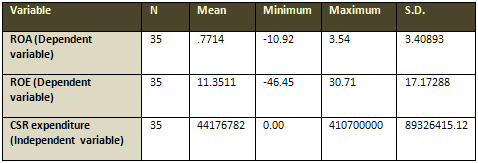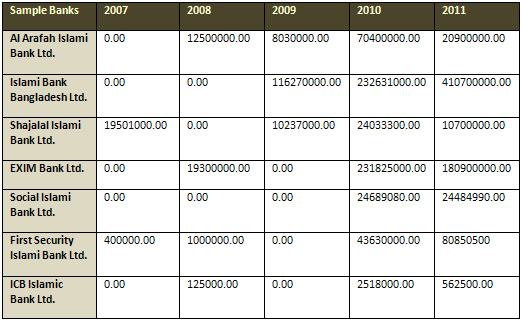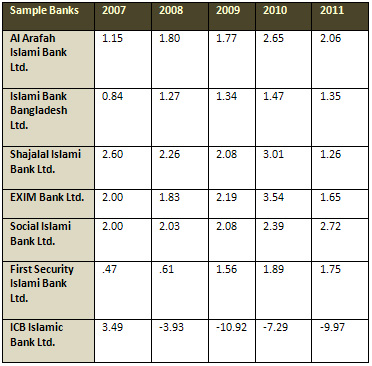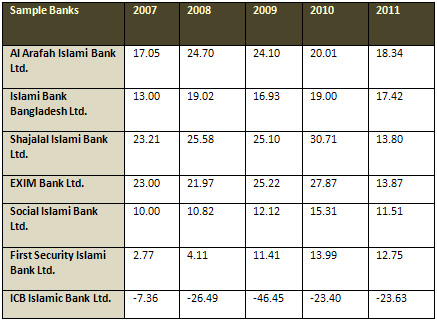|
Does
Corporate Social Responsibility Expenditure
Affect Financial Performance of Islamic
Banks in Bangladesh?

Mehedi Hasan Tuhin
Correspondence:
Mehedi Hasan Tuhin
Assistant Professor
Dept. of Business Administration
Sylhet International University
Shamibabad, Bagbari, Sylhet, Bangladesh.
Email: mehedi_siu@yahoo.com

Abstract
The aim of this study is to measure
the impact of corporate social responsibility
(CSR) expenditure on Islamic banks'
financial performance in Bangladesh.
The Return on Asset (ROA) and Return
on Equity (ROE) are used as proxy
for financial performance of bank
for this study. The data of CSR expenditure
and the performance variable are collected
from all seven full-fledged Islamic
banks in Bangladesh for the period
2007-2011. The simple regression analysis
is applied to test the association
between CSR expenditure and the bank's
financial performance. The results
show that there is no significant
impact of CSR expenditure on Islamic
banks' financial performance.
Keywords: Corporate Social
Responsibility; Financial Performance;
Islamic Banks; Bangladesh.

1. Introduction
Corporate Social Responsibility (CSR)
has become an issue of global concern.
CSR is the process by which an organization
evolves its relationships with stakeholders
for the common good. Social responsibility
means not only fulfilling legal expectations,
but also going beyond compliance to
fulfill social needs. Through CSR
corporate entities visibly contribute
to the social good. Thus CSR is no
charity or mere donations. Socially
responsible companies use CSR to incorporate
economic, environmental and social
objectives with the company's operations
and development.
CSR activities practiced by banks
can create awareness about banking
activities and increase loyalty among
customers, depositors, and employees
of the bank. The banking sector contributes
to the society as part of CSR in the
form of education, health, and environment
etc which can stimulate sustainable
economy developments. Through CSR
activities, a bank overcomes the barrier
between bank and society. As a result,
both deposit and investment improves
with the increase of CSR expenditure.
On the other hand, implementing CSR
activities is costly for banks and
it enhances the total cost which might
reduce the impact of CSR activities
on the banks' profit in the short-run.
Though the cost of the banks enhances
with the CSR activities in the long
run it has a good impact on a bank's
performance. CSR builds up stakeholders'
confidence and creates a good corporate
image of the bank.
CSR activities are relevant with
Islamic laws. As per Islamic Shariah
all Islamic financial institutions
should be involved and perform social
responsibility to the society. According
to Sadeq (2007) the prime objectives
and functions of Islamic banks are
the betterment of general human being;
bringing about social and economic
benefits to the Islamic world; making
brotherhood, social equality and equitable
distribution in Muslim societies;
establishment of distributive justice;
development and support of small scale
enterprises; discharging of corporate
social responsibility, including its
disclosure. Farook (2007) identified
the three major foundational principles
for Islamic Corporate Social Responsibility
i) The principle of vicegerency ii)
The principle of divine accountability
iii) The principle of enjoining good
and forbidding evil. In the view of
Sairally (2005), Islamic banks should
be accountable not only to the success
of the industry but also towards the
community, on top of being responsible
to Allah. In other words, to be consistent
with the objective of Islamic moral
economy, Islamic banks need to realize
social responsibility in order to
promote socio-economic development.
In the context of Bangladesh, the
practice of CSR prevails in the banking
sector of Bangladesh. Islamic banks
can play a significant role towards
stakeholder and towards the society
through CSR activities. But do CSR
activities have any positive or negative
impact on their financial performance?
In this paper I have tried to find
out the answer of this question. Many
studies have been conducted and various
arguments have been made regarding
the relationship between financial
performance and CSR. However, the
existing evidence is inconclusive
and hence there is need for more studies
to provide research evidence in this
context.
CSR activities are in a naive stage
and proper application of CSR is not
present at this moment in Bangladesh.
Therefore, the findings of this study
would be helpful to the society, depositors,
investors, employees, and decision
makers regarding the impact of CSR
on Islamic Bank's performance. It
is expected that the study would enrich
the existing literature by providing
empirical evidence from Bangladesh
in this regard.
The remainder of this paper is organized
as follows. Section two outlines the
research objectives of the study.
Literature review and hypotheses development
are discussed in section three and
four. Section five describes research
method. Section six discusses findings
of the study and section seven makes
concluding remarks of the study.
2. Objectives
The main aim of this study is to measure
the impact of CSR expenditure on the
financial performance of Islamic Banks.
To achieve the objective, two sub-objectives
have been set which are as follows:
1. To find the relationship between
CSR expenditure and ROA of the Islamic
banks.
2. To find the relationship between
CSR expenditure and ROE of the Islamic
banks.
3. Literature Review
A number of studies have been carried
out in both developed and developing
countries to measure the impact of
CSR on banks' financial performance.
Margolis, Elfenbein and Walsh (2009)
stated that there are more than 200
published studies on this subject
and yet there is no clear consensus
on the relationship between CSR and
corporate financial performance.
Wright and Ferris (1997) found a negative
relationship between CSR and financial
performance of a firm but Posnikoff
(1997) reported a positive relationship
and McWilliams and Siegel (2000) found
inconsistent results regarding the
relationship between CSR and short
run financial returns. Teoh, Welch
and Wazzan (1999) found no relationship
between CSR and financial performance.
Konar and Cohen (2001) argued that
a firm with a better environmental
performance has a significant positive
impact on its market value. According
to Dam (2006), there are in fact strong
linkages between corporate social
responsibility and financial performance.
Fauzi (2009) found that CSR has no
effect on financial performance. Arshad,
Othman and Othman (2012) stressed
the impact of CSR on Malaysian Islamic
banks' performance and found that
CSR was significantly positively related
to firm performance as measured by
ROA and ROE. Samina (2012) found a
strong positive correlation between
CSR Expenditure and Bangladeshi Islamic
banks' performance (Investment, Deposit,
Profit). Weshah, Dahiyat, Awaad, &
Hajjat (2012) found a significant
positive relationship between (CSR),
bank size, the level of risk in the
bank on one hand and financial performance
on the other hand in the Jordanian
banking companies. Islam, Ahmed and
Hasan (2012) revealed that the average
return on asset ratios of the banks
having high Corporate Social Performance
(CSP) is higher compared to that of
the banks having low CSP, though this
could not be proved statistically.
Hossain and Alam (2012) indicate that
the relationship between investment
in CSR and market price per share
is statistically significant; on the
contrary the relationship between
investment in CSR and net asset value
per share is not statistically significant
at 5% level of significance. Malik
and Nadeem (2012) verified the relationship
between EPS, ROA, ROE, Net Profit
and CSR using regression models and
found that there is positive relationship
between profitability (EPS, ROA, ROE,
and Net Profit) and CSR. Flammer (2013)
argues that adopting a CSR-related
proposal leads to superior financial
performance.
4. Hypotheses
Based on objectives of the study two
specific hypotheses have been formulated.
Hypothesis 1: There is positive
correlation between CSR expenditure
and ROA of the Islamic banks.
Hypothesis 2: There is positive
correlation between CSR expenditure
and ROE of the Islamic banks.
5. Methodology
Out of banking institutions, the study
concentrates only on the listed Islamic
Shariah-based banks in Bangladesh.
On December 31, 2012 there were 7
full-fledged Islamic banking companies
listed on Dhaka Stock Exchange (DSE)
and Chittagong Stock Exchange (CSE).
All seven banking companies listed
on the DSE and CSE are selected. The
study is based on secondary data.
Necessary data have been collected
from annual reports, web-sites and
publications of Bangladesh Bank. The
period of the current study covers
five years from 2007 to 2011.
Model Development
To investigate the impact of CSR expenditure
on ROA, it is assumed that-
Y1= a+b1x1
Where, Y1 = ROA in terms of percentage,
a= constant term,
b1 = Regression coefficients for the
independent variable,
x1 = CSR expenditure in BD Taka
Here, Y1 (i.e. ROA) is the dependent
variable, while the x1 is the independent
variable.
To investigate the impact of CSR
expenditure on ROE, it is assumed
that-
Y2= a+b2x2
Where, Y2 = ROE in terms of percentage,
a= constant term,
b2 = Regression coefficients for the
independent variable,
x2 = CSR expenditure in BD Taka
Here, Y2 (i.e. ROE) is the dependent
variable, while the x2 is the independent
variable.
6. Findings
6.1 Descriptive Statistics
Table 1 reports the descriptive statistics
of the ROA, ROE and CSR expenditure
of sample banks. The table indicates
that the mean of CSR expenditure is
about 44176782 BD Taka. It also shows
that the extent of CSR expenditure
has a considerable range. While the
minimum is 0.00 BD Taka, the maximum
is 410700000 BD Taka. As indicated
in the table, ROA and ROE of listed
banks have also wide ranges. ROA ranges
from -10.92 % to 3.54% while ROE ranges
from -46.45% to 30.71%.
Table 1: Descriptive Statistics
for Independent and Dependent Variables

6.2 Regression Analysis
6.2.1
CSR Expenditure and ROA
The results of the regression analysis
of the association between ROA and
CSR expenditure of listed Islamic
banks are documented in the following
section.
Table 2: Regression Results
Panel A: Model Summary

a. Predictors: (Constant), CSR expenditure
Panel B: ANOVAa

a. Dependent Variable: ROA
b. Predictors: (Constant), CSR expenditure
Panel C: Coefficientsa

a. Dependent Variable: ROA
The above table reveals that F value
is not significant at .328 level.
This indicates that the variation
caused by CSR expenditure in the ROA
is not significant.
The value of Correlation Coefficient
(R) and Coefficient of Determination
(R square and Adjusted R square) of
the model are also shown. The value
of correlation coefficient is .170
and R square is .029. These show that
the independent variable under reference
has very low degree of correlation
with ROA. According to the results,
we can conclude that CSR expenditure
of Islamic banks have no significant
influence on their financial performance
measured by ROA. Thus, Hypothesis
1 is not supported.
6.2.2 CSR
Expenditure and ROE
The results of the regression analysis
of the association between ROE and
CSR expenditure of listed Islamic
banks are documented in the following
section.
Table 3: Regression results
Panel A: Model Summary

a. Predictors: (Constant), CSR expenditure
Panel B: ANOVAb

a. Predictors: (Constant), CSR expenditure
b. Dependent Variable: ROE
Panel C: Coefficientsa

a. Dependent Variable: ROE
The above table reveals that F value
is not significant at .203 level.
This indicates that the variation
caused by CSR expenditure in the ROE
is not significant.
The value of Correlation Coefficient
(R) and Coefficient of Determination
(R square and Adjusted R square) of
the model are also shown. The value
of correlation coefficient is .221
and R square is .049. These show that
the independent variable under reference
has a very week degree of correlation
with ROE. According to the results,
we can conclude that CSR expenditure
of Islamic banks have no significant
influence on their financial performance
measured by ROE. Thus, Hypothesis
2 is also not supported.
Ullmann (1985) stated that as there
are many variables in between CSR
and a firm's financial performance,
it is very difficult to find any significant
relationship between these two measures.
McWilliams and Siegel (2000) stated
that if any kind of relationship prevails
between CSR and financial performance,
it would disappear with incorporation
of more accurate variables such as
R&D into the economic models.
Another cause might be that CSR often
provides indirect competitive advantages
which in turn make it difficult to
measure its connection to financial
performance. These arguments are supported
from the findings of this study.
7. Conclusion
The practice of CSR in financial institutions
has brought a new dimension to the
social economic scenario of Bangladesh.
Though CSR activities are being practiced
by Islamic banks to a certain extent,
doubt remains as to whether such initiatives
could potentially lead to better performance
and sustained competitive advantage.
Previous studies have provided conflicting
results regarding the relationship
between CSR and financial performance.
Our findings from this study suggest
that CSR activities of Islamic banks
do not have significant influence
on their financial performance.
Although no significant relationship
has been found between CSR and financial
performance, the management of Islamic
banks should be committed to CSR activities
in the future as it will be a prerequisite
to attract and retain customers and
employees and thus survive in the
market. It is to be noted that performing
some CSR activities is not enough
to contribute financial performance.
Islamic banks should properly select
the right kind of CSR activities and
perform them with great care. It should
be consistent with a long-term plan
rather than a short-term business
solution.
Appendices
Appendix 1: Sample Banks' CSR
Expenditure 2007-2011 (Figures in
Taka)

Source: Bangladesh Bank (2012)
Appendix 2: Sample Banks' ROA
2007-2011 (Figures in Percentage)

Source: Annual Reports 2007-2011
Appendix 3: Sample Banks'
ROE 2007-2011 (Figures in Percentage)
Source: Annual Reports 2007-2011
References
Arshad, R., Othman, S., & Othman,
R. (2012). Islamic Corporate Social
Responsibility, Corporate Reputation
and Performance. World Academy of
Science, Engineering and Technology
, 64, 1070-1074.
Dam, L. (2006). Corporate Social Responsibility
and Financial Performance. Retrieved
from http://dissertations.ub.rug.nl/FILES/faculties/feb/2008/l.dam/c2.pdf
Farook, S. (2007). On Corporate Social
responsibility of Islamic Financial
Institutions. Journal of Islamic Economic
Studies , 15 (1), 31-46.
Fauzi, H. (2009). Corporate Social
and Financial Performance: Empirical
Evidence from American Companies.
Retrieved from http://ssrn.com/abstract=1489494.
Flammer, C. (2013). Does Corporate
Social Responsibility Lead to Superior
Financial Performance? A Regression
Discontinuity Approach. Retrieved
from http://ssrn.com/abstract=2146282.
Hossain, M. E., & Alam, M. Z.
(2012). Impact of Investment in Corporate
Social Responsibility on Financial
Performances of Some Financial Institutions
Listed in Dhaka Stock Exchange. Asian
Journal of Management Sciences and
Education , 1 (2), 31-43.
Islam, Z. M., Ahmed, S. U., &
Hasan, I. (2012). Corporate Social
Responsibility and Financial Performance
Linkage: Evidence from the Banking
Sector of Bangladesh. Journal of Organizational
Management , 1 (1), 14-21.
Konar, S., & Cohen, M. (2001).
Does the Market Value Environmental
Performance? Review of Economics and
Statistics , 83 (2), 281-289.
Malik, M. S., & Nadeem, M. (2014).
Impact of corporate social responsibility
on the financial performance of banks
in Pakistan. International Letters
of Social and Humanistic Sciences
, 10 (1), 9-19.
Margolis, J. D.; Elfenbein, H. A.
and Walsh, J. P. (2009). Does it Pay
to Be Good...And Does it Matter? A
Meta-Analysis of the Relationship
between Corporate Social and Financial
Performance. Retrieved from http://ssrn.com/abstract=1866371
McWilliams, A., & Siegel, D. (2000).
Corporate Social Responsibility and
Financial Performance: Correlation
or Misspecification. Strategic Management
Journal , 21, 603-609.
Posnikoff, J. F. (1997). Disinvestment
from South Africa: They did well by
doing good. Contemporary Economic
Policy , 15 (1), 76-86.
Sadeq, A. M. (2007). Comment on Corporate
Social Responsibility Paper by Farook
and Lanis; and Sirally. Proceedings
of the 6th International Conference
on Advances in Islamic Economics and
Finance, Advances in Islamic Economic
and Finance, Islamic Research and
Training Institute, Jeddah, Saudi
Arabia.
Sairally, S. (2005). Evaluating the
'Social Responsibility" of Islamic
Finance: Learning from the experiences
of Socially Responsible Investment
Funds. Sixth International Conference
On Islamic Economics, Jakarta, Indonesia.
Samina, Q. S. (2012). Practice of
Corporate Social Responsibility in
Islamic Banks of Bangladesh. World
Journal of Social Sciences , 2 (6),
1-13.
Teoh, S. H., Welch, I., & Wazzan,
C. P. (1999). The effect of socially
activist investment policies on the
financial markets: Evidence from the
South African boycott. Journal of
Business , 72 (1), 35-89.
Ullmann, A. A. (1985). Data in Search
of a Theory: A critical Examination
of the Relationships among Social
Performance, Social Disclosure and
Economic Performance of U.S. Firms.
Academic Management Review , 10, 540-557.
Weshah, S. R., Dahiyat, A. A., Awaad,
M. R., & Hajjat, E. S. (2012).
The Impact of Adopting Corporate Social
Responsibility on Corporate Financial
Performance: Evidence from Jordanian
Banks. Interdisciplinary Journal of
Contemporary Research in Business
, 4 (5), 34-44.
Wright, P., & Ferris, S. (1997).
Agency conflict and corporate strategy:
The effect of divestment on corporate
value. Strategic Management Journal,
18 (1), 77-83.
References
|